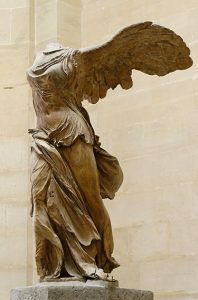
For the sculptor, this was completely practical as some free-standing figures in a sculptural work usually require some support like Eros’ link, Pan’s extending leg, his hand on Aphrodite, and his bottom sitting on an unidentifiable object. These ways of support allow the figures to stay together instead of falling apart as it is a method of combing the weight altogether creating a balance within the entire piece visually and physically. Not only did it create balance but also the remarkable closed spaces between the figures, quite triangular at some point between the top and bottom of the piece. And because of the supports and the closed spaces between the figures, Pan appears to twist Aphrodite around in a spiral pattern that leads to a compositional illusion of movement.
Winged Victory (Nike) of Samothrace and Aphrodite, Pan, and Eros are two of the most important works of Greek art as each have introduced a new style to the Hellenistic period: Hellenistic Baroque and Hellenistic Rococo. The Hellenistic baroque style displays an emphasis on drama, a strong appeal to pathos, and distinctness. Physically, the work is done in very high relief, even more so than before, and almost in the round. Conceptually, it’s about communication of emotions between the work and the public. Therefore, this style perfectly describes the Winged Victory (Nike) of Samothrace. Shortly after this style was introduced, another one surfaced as Hellenistic artists started to add sensualistic yet casual attributes to baroque-styled sculptures. This is described as the Hellenistic Rococo style. While this style is not only similar to the Baroque style, it’s actually of Baroque but with more of a comical sense, almost satirical-like. This term precisely fits the theme of Aphrodite, Pan, and Eros. These figures are three of the most well-known characters in Greek mythology and this sculpture does nothing but paradoxically show a humorous confrontation between Aphrodite, Pan, and Eros.
Historical and Cultural Context/Meaning

The sculpture of the goddess depicts her as winged woman just touching down on the prow of a ship (the Rhodian marble base) in a gale wind as the prow of the ship represents the naval victory bestowed upon Antiochus and his men. The society this work of art was created in may see the concept of triumph or conquest as highly regarded as the Hellenistic culture contained several prominent conqueror figures especially the Romans. In its original condition, the commemorative statue once stood on a rocky terrace, overlooking the sea and theater of the Sanctuary of the Great Gods. It was placed upon a pool of water, where the stone ship appeared to float. Currently, it is on display at the Louvre in Paris, France. At Delos, Greece, the sculptural group Aphrodite, Pan, and Eros was discovered in a clubhouse of a group of merchants. While the artist was unknown, the archaeologists believes that this work of art is indeed a copy of the original. Like the artist, the function of this work is a mystery as well, with the question being whether it was created as a decorative piece or a cult image. As the meaning of this piece is only a showcase of humor and parody between the popular characters of Greek mythology, it is merely a casual encounter between the three figures that mocks their power.





